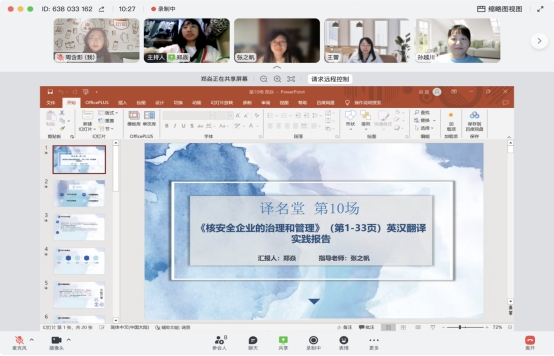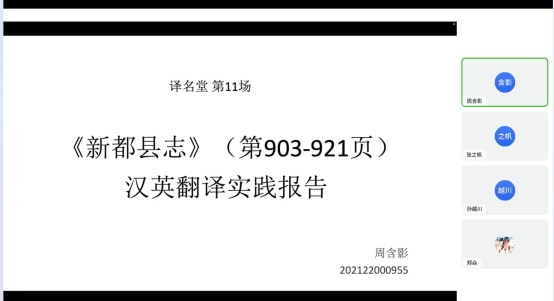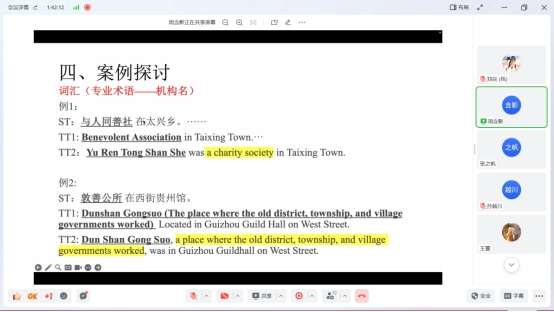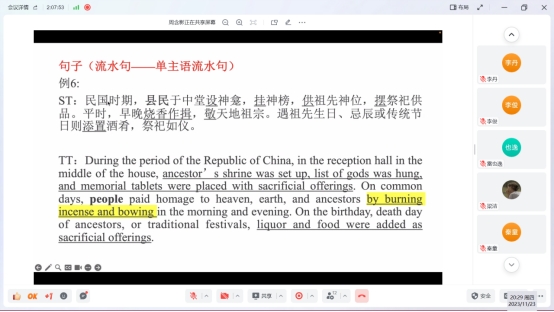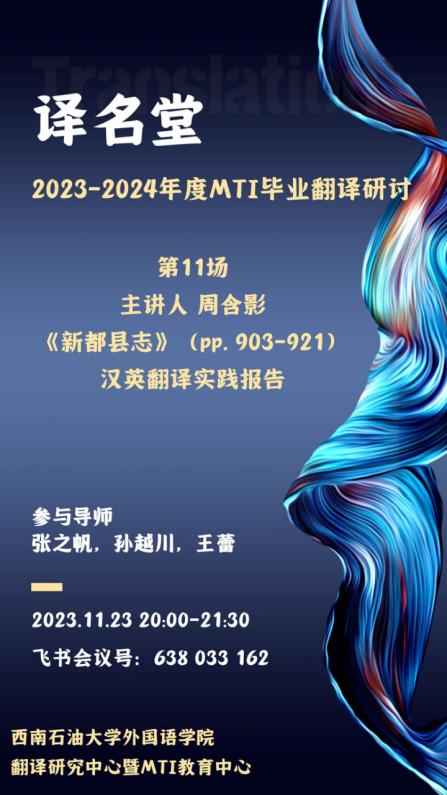
内容简介:
《新都县志》全书共31篇内容,从大事记述开始,介绍了新都的建置、自然地理、人口、党派和群团、政权和政协、司法、人事和劳动、民政、军事、经济管理、农业、林牧副渔、水利、工业、乡镇企业、交通、邮电、商业和贸易、财政和税务、金融、城乡建设与环境保护、文化、教育、科技、卫生、体育、文物和名胜、社会风土、人物,最后以余编结束。《新都县志》的时间上限为1911年,下限至1985年,有的篇章根据需要作了适当的上溯或下延。为了总结历史经验教训,《新都县志》客观地记载了从辛亥革命以来,新都县历史发展的基本情况,反映从旧民主主义革命到社会主义革命和建设中,全县人民英勇斗争和忘我劳动的光辉业绩,是了解县情历史的宝贵文化遗产;同时,《新都县志》也反映了社会主义时代特点和地方特色,对进一步发挥新都县经济优势,继承和创新本地名特产品,开发新的资源和高新技术,发展旅游事业,维护自然环和生态平衡,都将起到重要作用。
译者在此次翻译实践中分配到的任务是翻译此书第903至921页的内容,主要涉及部分社会组织和风俗两部分内容。
译文修改:
例1:
ST:与人同善社在太兴乡。······
TT1:Benevolent Associationin Taixing Town.···
TT2:Yu Ren Tong Shan Shewasa charity societyin Taixing Town.
TT3: Yu Ren Tong Shan Associationwasa charity societyin Taixing Town.
例2:
ST:男女青年到一定年龄时亲朋邻居为之作伐,选择门当户对、品德才貌相当的作为婚配对象。经过“访人户”、“合婚”、“看人”、“报期”等过程决定结为配偶。结婚前夕,男方备办衣饰、礼物送往女家,并带回女方陪奁,称为“过礼”。当晚男方簪花挂红,吃“花夜酒”。婚日晨,女方举行辞祖仪式。婚日,男方备鼓乐、彩旗、花轿,迎新娘,称为“迎亲”。新娘至,即行“周堂”,拜天地、拜祖宗、拜父母、拜长辈、夫妻交拜,然后双双进入洞房,共饮交杯酒,结婚礼仪初告完毕。
TT1:When young men and women reached a certain age, their relatives, friends, and neighbors acted as matchmakers, choosing people who were of the same family and had similar moral and talent as the marriage partners.After the parents of both partiesexamined each other's families through various relationships, checked whether the man’s and woman’s date of birth and eight characters match or not, and met with the parents and matchmakers of both parties, the date of marriage was chosen to decide whether to become a spouse. On the eve of marriage, the man prepared clothing and gifts to send to the woman's house, and brings back the bride's dowry, known asthe bride-receiving and gift-giving customs.The man wore a hairpin and hung red, holdinga banquet for his last bachelor day. On the morning of the wedding day, the woman held a ceremony to bid farewell to her ancestors. The man prepared drums, flags, and sedan chairs to welcome the bride, which is called“welcoming the bride”.Upon the arrival of the bride, both husband and wife began the wedding ceremony at auspicious time, paying respects to heaven and earth, ancestors, parents and elders, and bowing to each other. Then, both entered the bridal chamber and drinkcross-cupped wine. Then the wedding ceremony was finally concluded.
TT2:When young men and women reached marriageable age, their relatives, friends, and neighbors would act as matchmakers to choose people who were of the same social class and had similar virtues as the marriage partners. After the process ofFang Ren Hu, He Hun, Kan Ren, and Bao Qi, the marriage would be done. On the eve of marriage, the groom’s prepared clothing and gifts to send to the bride’s house, and brought back the bride's dowry, known asGuo Li.The groom wore a hairpin and hung red, holding a banquet calledHua Ye Jiu feast.On the morning of the wedding day, the woman held a ceremony to bid farewell to her ancestors. The man asked someone to play music, wave flags, and carry a sedan chair to welcome to bride, which is calledYing Qin.Upon the arrival of the bride, the newlyweds began the wedding ceremony at auspicious time, paying respects to heaven and earth, ancestors, parents and elders, and bowing to each other. Then, the newlyweds entered the bridal chamber and drinkJiao Bei Jiu wine,which was the end of the wedding ceremony.
例3:
ST:1976年县民政局在全县范围内开展扶贫工作。扶贫对象是那些由于主要劳动力死亡或主要劳动力病残、呆痴,或遭受意外不幸事故,或劳动力弱以致不能维持基本生活,不经扶持三五年难以改变贫困面貌的社员户(即严重困难户)。
TT1: In 1976, the poverty alleviation work was carried out by the Xindu County Civil Affairs Bureau.The targets of the workwereseverely disadvantaged householdsthat were unable to change their poverty-stricken status without support for three or five years,with the main labordead or disabled.
TT2: In 1976, the Xindu County Civil Affairs Bureau carried out poverty alleviation work throughout the county.The targets of poverty alleviationwerethose member householdsthat were unable to change their poverty-stricken status without support for three or five years(that is, households in severe hardship),in which the main labor force either passed away, were sick or disabled, were foolish, suffered unexpected accidents, or were born with weak labor force that could not sustain basic living.
研讨反思:
通过此次译名堂翻译研讨会,译者更加明确了进行该翻译项目的目的。在三位老师的帮助下,译者确定了部分专业术语、文化负载词、流水句、长句的翻译方法,并将一些不确定的译文提出来与老师们进行沟通,最后一起讨论出了更好的解决方案。
首先,在机构名称的翻译上,比如“与人同善社 在太兴乡”,译者提出TT1“Benevolent Association in Taixing Town”和TT2“Yu Ren Tong Shan She was a charity society in Taixing Town”两个译本。经查证,TT1中的“Benevolent”经常被用来命名国外的慈善机构,但《新都县志》中还会出现“仁和慈善会”、“仁德慈善会”等机构,这些机构名无法在目的语中找到既有译本,因此,为了使全文的机构名译法统一,译者更倾向用拼音的方式音译,这一点也得到了参会老师的认同。与此同时,老师们更建议用“拼音+性质属性”的方式来翻译机构名,如“与人同善社Yu Ren Tong Shan Association”和“仁德慈善会Ren De Charity Society”等。
其次,在讨论如何翻习俗礼仪类的文化负载词时,老师们建议使用“拼音+脚注”的方式来处理,且脚注中还需要出现拼音所对应的中文文化负载词本身,这样做一是为了使译文看起来更加简洁,做到在译本也能保持信息型文本的特点;二是为了目的语读者在查阅脚注时能够快速对应该文化负载词在原文中出现的地方,以免出现文化负载词“拼音+脚注”在译文中出现较多,目的语读者因此感到混淆的情况。
最后,金沙娱场城app7979关于中文定语、补语、状语修饰语过长的处理,老师们建议按照中文原文进行翻译,避免过多的删减和译者个人对其进行总结概括。《新都县志》本身承载的时间段就具有中国在不同时期的发展特点和时代性,如果译者按照现代化视角对其进行删减、总结概括式地翻译,会使《新都县志》失去时代特色,也将使译文成为一篇金沙娱场城app7979关于新都历史发展的导读性的文章,而不是详细记录新都各方面发展的百科全书。
十分感谢参加此次译名堂翻译研讨会的三位老师,译者在老师的帮助下学到了很多处理翻译问题的方法,也意识到译文中存在的不足之处,这些收获为后续修改译文提供了十分重要的参考价值。
照片:
